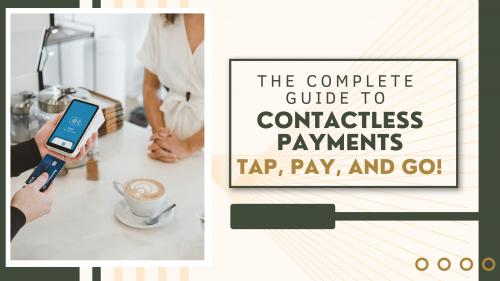The Complete Guide to Contactless Payments: Tap, Pay, and Go!

Contactless payments have become a game-changer, offering a faster, more convenient way to pay for your everyday purchases. But with so much information floating around, it can be confusing to understand how they work and what the pros and cons are.
Deep dive into contactless payments, addressing everything from the technology behind them to the benefits they offer for both consumers and businesses.
Unveiling the Magic: How Contactless Payments Work
The secret behind contactless payments lies in two key technologies: Near Field Communication (NFC) and Radio Frequency Identification (RFID). When you tap your contactless card or mobile device on a payment terminal, an NFC chip within the card or device transmits encrypted payment information to the terminal using radio waves. This eliminates the need for swiping or inserting your card, and the entire process happens within seconds.
Security Concerns? Here's Why You Can Relax
One of the biggest concerns with contactless payments is security. After all, you're not entering a PIN for smaller transactions. Here's the good news: contactless payments utilize several security measures to protect your information.
EMV Chip Technology: Contactless cards use EMV chips that generate unique codes for each transaction, making it virtually impossible for criminals to steal your card details.
Tokenization: Many digital wallets use tokenization, where a unique digital identifier replaces your actual card number during transactions, adding another layer of security.
Transaction Limits: Most banks impose limits on contactless transactions, requiring a PIN for higher amounts.
Lost/Stolen Card Protection: Most banks offer zero-liability protection for unauthorized contactless transactions if you report your card lost or stolen promptly.
Beyond Convenience: Advantages of Contactless Payments
For consumers, contactless payments offer a multitude of benefits:
Speed and Convenience: Ditch the queues and lengthy checkout processes. Simply tap and go!
Enhanced Security: EMV chip technology and tokenization provide robust security features.
Hygienic Payments: Avoid touching potentially germ-infested POS terminals, especially relevant in today's world.
Loyalty Program Integration: Many e-wallets allow you to store loyalty cards and access them seamlessly during contactless payments.
Multiple Payment Options: Use your contactless card, smartphone, or smartwatch for payments, offering flexibility.
Businesses Rejoice! The Benefits of Contactless Payments
Contactless payments aren't just for consumers; businesses benefit too:
Faster Transaction Speeds: Reduce checkout lines and improve customer experience.
Lower Operational Costs: Eliminate the need for manual card processing, saving time and resources.
Increased Customer Satisfaction: Contactless Payments offer a convenient and secure payment trends that keeps customers coming back.
Data Insights: Track spending patterns and gain valuable customer data for better marketing strategies.
Considering the Drawbacks
While contactless payments offer a plethora of advantages, there are a few drawbacks to consider:
Limited Acceptance: While growing rapidly, contactless payments may not be accepted everywhere just yet.
Transaction Limits: As mentioned earlier, contactless transactions often have spending limits, requiring PIN verification for larger purchases.
Potential for Accidental Payments: Since PINs aren't required for smaller transactions, accidental payments due to misplaced cards or devices are a possibility.
E-wallets: The Future of Contactless Payments?
Mobile wallets like Apple Pay and Google Pay are revolutionizing contactless payments. These e-wallets store your payment information securely on your smartphone and allow for easy tap-and-go payments.
They often offer additional features like:
Biometric Authentication: Fingerprint or facial recognition for added security.
Loyalty Program Management: Store and access multiple loyalty cards in one place.
In-app Payments: Make purchases directly within apps without needing to enter card details.
Making the Switch
Ready to experience the convenience of contactless payments? Here's how to get started:
Check Your Card: Most new debit and credit cards come equipped with contactless technology, indicated by the Wi-Fi symbol with four wavy lines.
Activate Contactless Payments: Contact your bank for any activation steps required for your specific card.
The Future of Contactless Payments: What Lies Ahead?
Contactless payments are rapidly evolving, with exciting trends on the horizon that will redefine how we interact with money:
Increased Transaction Limits: As security measures continue to improve, transaction limits for contactless payments may rise in the future. Currently, many contactless transactions have lower limits compared to traditional chip-and-PIN methods. With advancements in encryption and fraud prevention, these limits are expected to increase, allowing users to make larger purchases with a simple tap.
Biometric Authentication for All: Fingerprint or facial recognition could become the norm for contactless payments. PIN verification, while secure, adds an extra step to the transaction process. Biometric authentication, however, offers a seamless and secure way to authorize payments. Imagine simply glancing at a terminal or placing your finger on a sensor to complete a purchase. This technology is already being piloted in some regions and is likely to gain wider adoption in the coming years.
Beyond Payments: A Multi-Functional Ecosystem
The future of contactless payments extends beyond just transactions. Here's a glimpse into the exciting possibilities:
Seamless Microtransactions: Imagine effortlessly paying for a newspaper, bus fare, or parking meter with a tap of your wearable. Contactless payments can streamline microtransactions, making them faster and more convenient than using cash.
Loyalty Programs and Gamification: Wearables can integrate seamlessly with loyalty programs, allowing users to redeem points instantly or receive personalized offers at the point of sale. Gamification elements can be introduced, rewarding users for frequent purchases and encouraging brand loyalty.
Secure Access and Identity Management: Wearables with biometric authentication can be used for secure building access, eliminating the need for keycards. They can even potentially act as digital IDs, streamlining identification processes.
Contactless payments are rapidly evolving, offering a glimpse into a future where transactions are faster, more secure, and more convenient than ever before. As technology advances and collaboration among stakeholders continues, contactless payments have the potential to become the preferred method for everyday transactions. Imagine a world where a simple tap of your wrist or a scan of your fingerprint takes care of everything from your morning coffee to your weekly groceries. The future of contactless payments is bright, and it's right around the corner.
Frequently Asked Questions
Q1: How do contactless payments work?
A1: Contactless payments use NFC and RFID technologies. When you tap your card or phone on a terminal, the NFC chip sends encrypted payment data using radio waves.
Q2: What security measures protect contactless payments?
A2: Security measures include EMV chips, tokenization, transaction limits, and lost/stolen card protection. EMV chips create unique codes, while tokenization replaces card numbers. Transaction limits and zero-liability protection guard against fraud.
Q3: What are the benefits of contactless payments?
A3: Consumers enjoy speed, convenience, security, hygienic transactions, loyalty program integration, and flexible payment options. Businesses benefit from faster transactions, lower costs, happier customers, and valuable data insights.







Comments